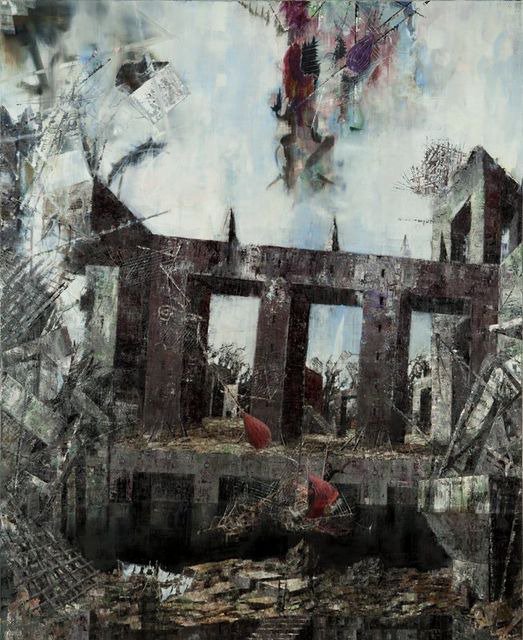Two exhibitions
dal 20/5/2011 al 17/6/2011
Segnalato da
20/5/2011
Two exhibitions
Galerie Fons Welters, Amsterdam
Michael Kunze (1961) has created a rich, complex oeuvre in what he calls the anachronistic medium of painting. The official history of modernism, running from Cezanne through the avant-gardes of the 20s to the neo-avant-gardes of the 60s, interests Kunze less than its shadow history, in which images are not associated with clear concepts. For all its glitter and sparkle, Myriam Mechita's magical world has an uneasy, alienating effect; the works presented make up a powerful total installation.

Michael Kunze
Ruperts Worte, Davids Stimme
Berlin-based German artist Michael Kunze (1961) has created a rich, complex oeuvre in what he calls the anachronistic medium of painting. Painting’s anachronistic qualities are ideally suited to Kunze’s investigation of the hidden face of modernism. The official history of modernism, running from Cezanne through the avant-gardes of the 20s to the neo-avant-gardes of the 60s, interests Kunze less than its shadow history, in which images are not associated with clear concepts. As Kunze sees it, this side of modernity includes all motifs and historical references that serve to confuse and obscure our image of the world. It’s a sort of anti-modern modernity, a large, dark cloud of rich associations, extending from Nietzsche’s studies of tragedy to Lars von Trier’s Antichrist.
Kunze contrasts American-oriented pop culture, with its pragmatic, positivist outlook so typical of our contemporary world, with a continental European way that is more difficult, more esoteric, and all but forgotten in our daily lives. The latter, according to him, is an intricately interconnected reservoir of idealistic, metaphysical and sceptical approaches that call seemingly obvious facts into question. He emphasises the importance of ‘high’ culture, which provides thought-provoking challenges rather than popular entertainment.
For his show Ruperts Worte, Davids Stimme, Kunze has produced two series of works. The first is based on scenes from Hitchcock’s film Rope (1948) in which two men murder their friend David only for the sake of the perfect murder. Inspired by a former teacher, Rupert (and indirectly by Nietzsche), they believe that culturally and intellectually superior individuals are not obliged to obey universal moral laws. But the silent voice of the murdered David, whose dead body is kept in the chest that serves as the dinner table, terrifyingly penetrates the space and makes the idea of superiority seem ludicrous. The words of Rupert, who is invited to join the dinner and ultimately brings the murder to light, show the rational irrationality of human beings and their inconsistent expectations.
The second series shows monumental architectural landscapes with their own logic, breathtaking scenes in which viewers can lose themselves, because nothing seems real or predictable. They probably represent the inner world of the human being, a dark, complex labyrinth with explosions of blinding light in which illusion is part of reality. The illusion of progress and the impossibility of clear thinking are also the themes of the only sculpture in the show: a large tripod covered with fur. This device, used by photographers and land surveyors to provide a stable base, is used as a kind of signature in many of Kunze’s paintings. It is not only a formal gesture and an image of exactitude; more fundamentally, the artist presents this object in an ironic spirit, questioning the possibility of fixed points of reference for humankind.
[Marta Gnyp]
-----
FRONT SPACE @ Galerie Fons Welters
Myriam Mechita
La chambre des mystères
For all its glitter and sparkle, Myriam Mechita’s magical world has an uneasy, alienating effect. The works presented in the Front Space of Galerie Fons Welters make up a powerful total installation. The legs of slender, deer-like creatures are so sharp that they are more evocative of horns or antlers. The animals lie flailing on the ground or are caught in constraining positions. Although they have been brutally decapitated, you can nonetheless hear their mute cries. The beads flowing like a stream of blood from one of the creatures’ necks presents, together with their sparkling, lacquered ‘hides’, a crude contrast with the visible violence.
As viewers, we seem to be confronted here with a nightmare that has come to an abrupt end. Tables are balanced on one another, and on boards that might serve as rafts. Caught in suspended motion, the elements combine to form a dynamic line. As in a narrative sequence, each island is linked to the next, an action is depicted that might resume at any moment. It remains a mysterious illusion, which defers its final significance in an interim space.
Also exhibited, in conjunction with this sculptural installation, are Mechita’s wallpapers. Embroidered on cloth canvases with colourful, repetitive patterns are holy figures with a plethora of sequins. Divorced from their context, it is the texture of their heavy-looking garments that captures our attention. And just as in Mechita’s sculptures, the head is missing. It is either being consumed by flames or evaporating in a black haze. The scenes are based on Fra Angelico’s Beheading of St Cosmas and St Damian (1438) – a painting in which the figures’ ghastly martyrdom is transfixed in a beautiful image. We are also put in mind of scenes of beheadings depicted by Caravaggio or Gericault. These artists depicted severed heads, while Mechita leaves us with the headless bodies. Like the mythical figure Acephalus, whose headlessness symbolised to the surrealist Georges Bataille liberation from the human form. Mechita emphasises in her turn the incompleteness and bestiality of a human being without a head, without thoughts.
Myriam Mechita (1974, Strasbourg) studied at the École des Arts Décoratifs de Strasbourg. Recent exhibitions of her work include shows at Bloomberg Space (London) and Le Parvis centre d’art contemporain (Tarbes).
[Rosa Juno Streekstra]
Image: Michael Kunze, Davids Stimme 1, 2011, oil oil on canvas280 x 230 cm
Opening: Saturday 21 May, 17:00 – 19:00
Galerie Fons Welters
Bloemstraat 140 - 1016 LJ Amsterdam
Opening hours: Tuesday to Saturday, 13:00 – 18:00



